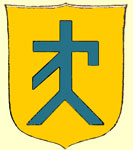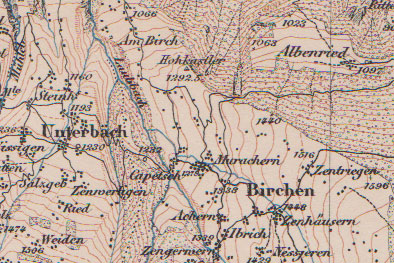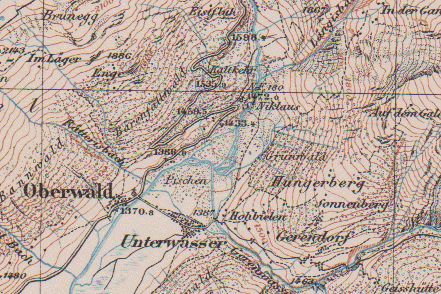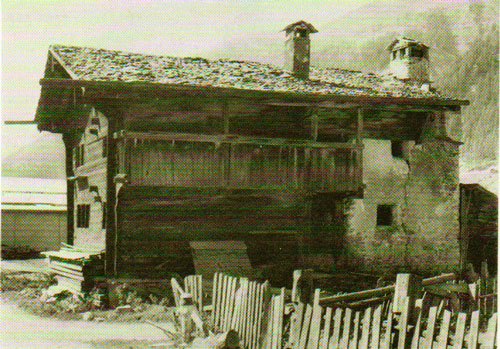
Hischier coat of arms
HischierThe Hischiers Swiss origin predates the formation of Switzerland as it is know today. Records show them in Buerchen since the 14th century and since the 17th century in Oberwald. Buerchen and Oberwald are German speaking villages in the eastern part of the Swiss Canton Valais. Today, Hischiers still live in Oberwald but in the late 1800s many emigrated to San Francisco, the Napa Valley and other sections of California, During the 19th century, spurred by famine and population growth, several waves of emigration brought hundreds of thousands of Swiss to North America. After 1848 Hischier went to California. As of 2007, California holds the largest number of Swiss-Americans. Until the mid-20th century the large majority of Hischiers
in Switzerland lived as hearty dairy cattle breeders and alpine farmers – cultivating
their own land, dedicated to harvesting enough hay in the short summertime
to feed their milk-cows during the long, dark wintertime. In the 18th century
and earlier, Hischiers are also mentioned as mercenaries, clerics, mayors
and governmental officers. |
|||||||
|
|||||||
_________________________________________ Origin of the name “Hischier” The ancient village of Unterwasser is now a section of Oberwald. There, you can find the house shown in the picture (since 1970 looking different after major modification). Inside you still find on a log with an inscription carved by by the builders: "DISEN.BW.HAT.CHRIST.VND.ANTHONI.VND.BALSER.ZN.HSR.BWN.
IM.IAR. 1620. Note: Family names as we know them today became common in the 14th and 15th centuries. Until the 18th century they had many variations and spellings, like Hissier, Hysiers, Ze Hischern, Zen Hischern, de Aedibus and Zenhaeusern. Those living today in Buerchen have kept the name Zenhaeusem. Despite the various spellings of the family name, all mean "People living in or coming from a place with the Name Zen Hischiern. Zen Hischiern was a hamlet in the Schattenberge (Shadow mountains) belonging to the parish of Unterbaech and the citizenship of Buerchen. Today this place is a part of the village of Buerchen and there you will find a bus station with the name Zenhaeusern. Zen and Ze means “To the”. The rest of the words mean “Houses” (aedibus = latin for houses). In today’s Valais German dialect one says for house (singular) = Huess, and for houses (plural) = Hischier or Hischini. _________________________________________ The Coat of Arms n the house built by the Hischiers in the year 1620 is a “Giltsteinofen” (oven made with soapstone). This oven is decorated with the characters 1626 and the Hischier coat of arms. The coat of arms shows the "Hauszeichen"( identification mark), used by the house owner. This identification mark was composed of the runes K for fire, L for water, N for misery and G for donations. These runes mean that fire and water shall not bring misery, but donations. _________________________________________ The forefathers In the 17th century the Valais parishes started recording births, marriages and deaths and since then proved descendencies are documented in Oberwald. For the Hischiers proved descendencies starts with the forefathers Cristian Hischier and Kaspar Hischier. Both were born about 1690 in Unterwasser (today a section of Oberwald). The Hischiers in the US are descendants of Kaspar. Note: Many Obergoms families have family trees starting in the 14th century. These family trees have been created by connecting possible ancestors, documented with name, place and time, but without any evidence of who was the father of whom. Exceptions are some families with documented descendencies back to the 16th and 15th centuries, like the Riedmatten from Muenster near Oberwald (they had 5 Valais bishops in their ranks). .Create family trees by "so it could have been" was till mid 20th century a common method. Regarding the forefathers of Hischier in Oberwald: It is sure, that they or their ancestors came from Buerchen and settled in Geren (today an abandoned village in the parish of Oberwald). We can assume they were descendants of one of the seven Zenhäusern/Hischier government officers, documted before 1721 in Geren. The first ot them was Johann (John), documented 1470/71. Government officers were elected for two years by the citizens of Buerchen to administer Geren. Geren was a possession of the citizens of Buerchen, Raron and Visp. Geren’s inhabitants had to pay tribute in alternate years to Buerchen, Raron and Visp. The administrator acted also as judge of Geren who had the right to pass death sentences. Administrators did not have a salary but kept a part of the tributes and had income from a large farm they managed with family members and/or servants, Another income source was to keep the fines charged to people they sentenced. For example, a judge took half the fortune of a witch he sentenced to death, after first leading the investigation – including torture. _________________________________________ Historical background Modern Switzerland began with the adoption of the Swiss Federal Constitution in 1848 which replaced what had been a loose defensive alliance of regions. In 1628, Valais had become a republic that lasted until 1798 when it was invaded by Napoleon’s French army. Some significant historical dates are: 25 BC-- Valais is part of the Roman Province of Rhaetia Remark about Democray 1475-1792: The inhabitants of the French speaking western Valais
and some areas of the German speaking eastern Valais (including the
village of Geren)
had no citizenship rights, had to pay tribute and were ruled by government
officers. As already mentioned, the administrator of Geren was frequently
a Hischier. In the other villages like generally spoken about 20% of
the adult male hat no citizen right. e. g, inhabitants living since generation
in the village but too poor to pay the one time fee for became a citizen,
e. g. illegal born males etc. |
|||||||
|
|||||||
__________________________ Written in June 2012 with the help of Stan Chambertin as lector, who not only forward the family try of the Hischier emigrated to Californa, but also inspired me with his questions to build a Hischier site in English, including some information about the historical background. Franco Werlen |
|||||||



